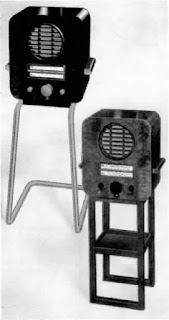Ekco is known to have produced stands for eight of its iconic Bakelite radios of the 1930s and 1940s. There is direct contemporary evidence, from an Ekco leaflet of 1935 (above), for stands for two of the company's five round radios - the AC/AD76 and the AD36, both inspired by Wells Coates' 1932 styling for the AD65 - and for the AC/AD86 'Dougal', styled by Serge Chermayeff. All three of these radios were released in 1935.



There's also photographic evidence of contemporary Ekco stands for the AC/AD85 of 1934, inspired by Wells Coates' design work (image not available for copyright reasons but available online); and for the AC/DC74 of 1933, styled by Chermayeff. Two stands were available for this last. One, in chromed tubular steel, price £1.15s.0d, for the black and chrome version of the set (above left, copyright Robert Chesters). Another, in wood, half the cost at £0.17s.6d, for the 'walnut' version (above centre).
A choice of wooden and chromed tubular steel stands, similar to those for the AC/DC74, were available for the AC/DC64, also styled by Chermayeff. A wooden stand could be had for the AD65 (above right). And, finally, an Ekco publication of 1936 for dealers lists a wooden stand for the AD37, although no image is known. No stands were available for the round A22 or AD75 radios. A complete collection of original Ekco stands would hold ten examples, excluding the wooden colour variants.
The wooden stands were of beech, and sported design cues that reflected those of the radio for which they provided support. They were available in both brown and black, likely coloured toner subsequently sealed with cellulose lacquer, to match the principal colours in which the radios were made. Stands without curves to the supporting platform are modern incarnations, not Ekco originals.

In about 1987 the radio and stand, still paired, passed locally to Graham Richardson, only the second owner. Now in the hands of its third owner, the radio (still entirely functional, without any restoration work having ever been done) and stand remain together. The stand is undoubtedly contemporary with the radio, and unique.
(My thanks to Robert Chesters for some of the information in this post.)



No comments:
Post a Comment